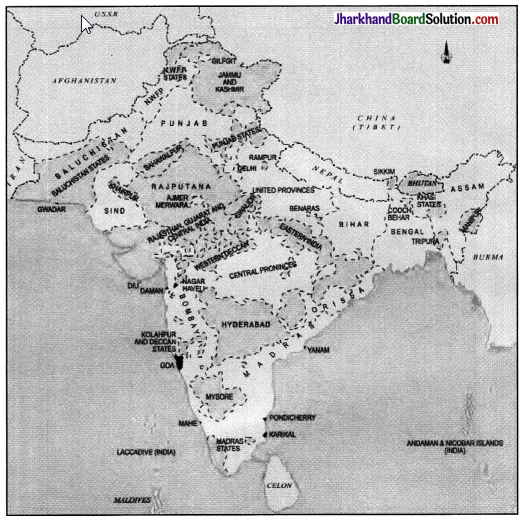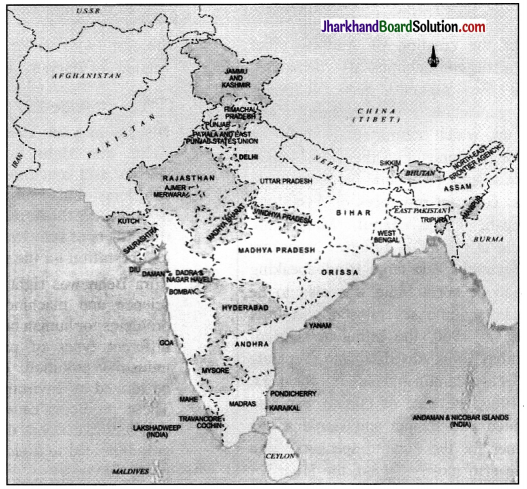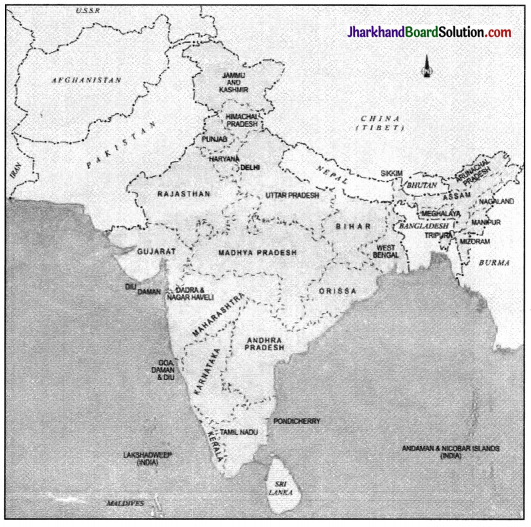JAC Board Class 8th Social Science Solutions History Chapter 9 The Making of the National Movement: 1870s–1947
JAC Class 8th History The Making of the National Movement: 1870s–1947 InText Questions and Answers
Page 111
Question 1.
From the beginning the Congress sought to speak for, and in the name of, all the Indian people. Why did it choose to do so?
Answer:
It choose to do so because it had to establish itself in order to achieve freedom from British.
Page 112
Question 2.
What problems regarding the early Congress does this comment highlight?
Answer:
The early Congress leaders were rich people and tied up with their own work and thus, they did not take much interest for the benefit of the organisation.

Page 114
Question 3.
Find out which countries fought the First World War.
Answer:
France, Britain, Russia, Italy and USA were the allies and fought against the Central Power which were Germany, Austria, Hungary, Bulgaria and Ottoman Empire.
Page 116
Question 4.
Find out about the Jallianwala Bagh massacre. What is Jallianwala Bagh? What atrocities were committed there? How were they committed?
Answer:
The Jallianwala Bagh is garden near Golden temple in Amritsar. This place shows the British’s brutality and harsh behaviour. The massacre took place on 13th April 1919. Baisakhi is held on this day. Around one thousand people gathered here to protest peacefully against the arrest of their leaders Dr. Satyapal and Dr. Saifuddin when this massacre happened.
Page 119
Question 5.
Read Source 4.
According to this report, how did people view Mahatma Gandhi? Why do you think they felt that he was opposed to zamindars but not to the . government? Why do you think they were in favour of Gandhiji?
Source 4:
“It was he who got bedakhli stopped in Pratapgarh” The following is an extract from a CID report on the kisan movement in Allahabad district, January 1921: The currency which Mr. Gandhi s name has acquired even in the remotest villages is astonishing. No one seems to know quite who or what he is, but it is an accepted fact that what he says is so, and what he orders must be done. He is a Mahatma or sadhu, a Pundit, a Brahmin who lives at Allahabad, even a deota … the real power of his name is to be traced back to the idea that it was he who got bedakhli [illegal eviction] stopped in Pratapgarh … as a general rule, Gandhi is not thought of as being antagonistic to Government, but only to the zamindars … We are for Gandhiji and the Sarkar.
Answer:
People view Mahatma Gandhi as sadhu, devta, a pandit. In Pratapgarh, he stopped bedakhali. People said that we are for Gandhiji and sarkar. They were in favour of him because of their immense faith.
Page 127
Question 6.
Imagine that you are involved in the Indian national movement. Based on your reading of this chapter, briefly discuss your preferred methods of struggle and your vision of a free India.
Answer:
Following are the methods of struggle and vision of a free India:
- Gandhian methods of struggle against the British rule based on non-violence, Satyagarha, truth.
- Such methods infused new energy in the freedom struggle.
- These methods were based on mass mobilization and participation and relied on the strength of common people.
- Like Gandhi, you would prefer the use Swadeshi, symbolic of India’s unique identity.
- Your vision of free India would be based on the principles of liberty, equality and justice.
- India which is based on democracy that allows for participation of the people in the political process.
- India based on gender equality, no caste based discrimination, and where all religions are respected.
- India of your dreams would be based on peace and harmony with all countries.
- Where poverty is eliminated, society which is characterized by growth and prosperity.
JAC Class 8th History The Making of the National Movement: 1870s–1947 Textbook Questions and Answers
( Let’s Recall)
Question 1.
Why were people dissatisfied with British rule in the 1870s and 1880s?
Answer:
People were dissatisfied with British rule in the 1870s and 1880s due to the following reasons:
(i) The Arms act of 1878: This act disallowed Indians to possess arms.
(ii) The Vernacular Press Act of 1878: This act allows the government to confiscate the assets of newspapers if they published anything that was found objectionable.
(iii) The Ilbert Bill of 1883: The bill provided for the trial of Britishers and Europeans by the Indian judges and sought equality between British and Indian judges in the country. But due to the opposition by whites, the bill was withdrawn. This enraged the Indians as this showed racial discrimination by them.

Question 2.
Who did the Indian National Congress wish to speak for?
Answer:
The Indian National Congress wish to speak for all the people of the country. This Party was composed of the representatives from all the sections of the Indian society.
Question 3.
What economic impact did the First World War have on India?
Answer:
The First World War had a major economic impact on India. The First World War caused a huge shortage of everything on our economy. The government was spending a huge amount on defense. To bear these expenses, it imposed huge taxes on lands. The prices of various commodities increased enormously which created difficulties for the common people. On the other hand, business houses were gaining huge profits due to the increased demand of industrial goods such as jute bags, cloth and rails. Hence, Indian industries expanded during the war.
Question 4.
What did the Muslim League resolution of 1940 ask for?
Answer:
The Muslim league made a resolution that asked for independent states for Muslims in the North Western and Eastern areas of the country in 1940.
(Let’s Discuss)
Question 5.
Who were the Moderates? How did they propose to struggle against British rule?
Answer:
Moderates were the Congress leaders in the first twenty years of its formation. They proposed to struggle against the British in a non-violent and peaceful manner. They wanted to develop public awareness about the unjust nature of British rule. They published many articles in the newspapers and journals emphasising about the increasing poverty of the country under the British rule. They criticised and condemned the British rule in their speeches. Representatives were sent to different parts of the country to mobilise and organise public support. The leaders thought that the British had respect for the ideals of freedom and justice, hence would accept the demands of Indians. Their main aim was to express their demands and make the government aware of the feelings of Indians.
Question 6.
How was the politics of the Radicals within the Congress different from that of the Moderates?
Answer:
The politics of the Radicals within the Congress were different from that of the Moderates in the following manner:
- Radicals argued that instead of believing on the so called good intentions of the British, people should fight for swaraj.
- Some leaders such as Lala Lajpat Rai, Bal Gangadhar Tilak and Bepin Chandra Pal (Lal-Bal-Pal) criticised the Moderates for their ‘policy of prayers’ and emphasised on self-reliance and constructive work.
- They supported and advised mass mobilisation and boycott of British institutions and goods.
- Some leaders also suggested ‘revolutionary violence’ to overthrow British rule.
- Moderates, on the other hand, ‘ proposed to struggle against the British in a non-violent and peaceful manner. They wanted to follow the rules, the laws and the order posed by the British.
Question 7.
Discuss the various forms that the Non-Cooperation Movement took in different parts of India. How did the people understand Gandhiji?
Answer:
Non-Cooperation Movement started in 1920. The various forms taken by the Non-Cooperation Movement in different parts of India are as follows:
(i) In tea gardens of Assam, labourers demanded an increase in their pay and started following Gandhiji.
(ii) At Kheda in Gujarat, Patidar peasants organised non-violent campaigns against the high land revenue demand of the British.
(iii) In coastal Andhra and interior Tamil Nadu, liquor shops were picketed and blockade was done.
(iv) In Sind which is now in Pakistan, Muslims traders and peasants supported the Khilafat and the noncooperation movement.
(v) In Guntur district of Andhra Pradesh, ‘forest satyagrahs’ were staged by the tribals and poor peasants who grazed their cattle in the forests without paying the grazing fees.
(vi) In Bengal also, the Khilafat and Non-Cooperation alliance gave enormous communal unity and strength to the national movement.
(vii) In Punjab, the Akali agitation and distress of the Sikhs demanded to remove corrupt mahants who supported by the British from their gurdwaras.
(viii) In other parts of the country, thousands of students left government schools and colleges. Many lawyers like Motilal Nehru, C.R. Das, C. Rajagopalachari and Asaf Ali gave up their practices. People surrendered their titles and boycotted legislatures. People lit public bonfires of foreign cloth. People thought of Gandhiji as a kind of saviour, as someone who could help them overcome their misery and poverty. Peasants believed that he would help them in their fight against zamindars and agricultural labourers believed he would provide them with the land.

Question 8.
Why did Gandhiji choose to break the salt law?
Answer:
Gandhiji chose to break the salt law because the British introduced a law stating that the Government had control over the manufacture and sale of salt. They imposed a tax on the sale of salt also. Mahatma Gandhi and other national leaders argued that salt was an essential item of our food and hence it was wrong to impose a tax on salt. Moreover, the issue of salt was related to all be it the rich or the poor.
Question 9.
Discuss those developments of the 1937-47 period that led to the creation of Pakistan.
Answer:
In 1937, the provincial elections held and convinced Muslim league that Muslims were a minority and they would always have to play second position in any democratic structure. In 1940, the Muslim league passed a resolution demanding independent states for Muslims in the north western and eastern areas of the country. In 1945, at the end of the Second World War, the British started discussions . and talks with the Congress and the League for the independence of India. The talks failed because the league saw itself as the sole spokesperson of India’s Muslims.
In 1946 elections, the Muslim league succeeded in the areas where seats were reserved for Muslims. In March 1946, the British cabinet sent a three member mission to Delhi to examine the best suited political framework for a free India. It suggested that India should constitute itself as a loose alliance with some autonomy for the Muslim majority areas. But both Congress and Muslim League did not agree to this. The Muslim League announced “Direct Action Day” on 16th August 1946. The failure of the Cabinet Mission made partition inevitable. Riots broke out in which thousands of people were turned homeless or were killed. Women had to face brutality and atrocities. Ultimately in 1947 partition took place and the country of Pakistan was bom.
(Let’s Do)
Question 10.
Find out how the national movement was organised in your city, district, area or state. Who participated in it and who led it? What did the movement in your area achieve?
Answer:
Students need to do it on their own.
Question 11.
Find out more about the life and work of any two participants or leaders of the national movement and write a short essay about them. You may choose a person not mentioned in this chapter.
Answer:
Life and Work of leaders who were involved in the national movement:
Sardar Vallabhbhai Patel Vallabhbhai Jhaverbhai Patel (31st October 1875 – 15th December 1950) popularly known as Sardar Patel, was an Indian politician. He hailed from an impoverished peasant proprietor family of Nadiad, Gujarat. From 1918 onwards, he was an eminent organiser of the freedom movement. He also served as a President of Congress in 1931. He played an important role in the negotiations for freedom and independence during 1945- 47.

He was fondly called the Iron Man of India. He served as the first Deputy Prime Minister of India. Subhash Chandra Bose Subhas Chandra Bose (23 January 1897 – 18 August 1945) was an Indian nationalist whose defiant patriotism made him a hero in India. Bose had been a leader of the younger, radical, wing of the Indian National Congress in the late 1920s and 1930s, rising to become Congress President in 1938 and 1939.
The Indian National Army (INA; Azad Hind Fauj, Free Indian Army) was an armed force formed by Subhash Chandra Bose. His most famous quote was “Give me blood and I will give you freedom”. Another famous quote was Dilli Chalo ! This was the call he used to give the INA armies to motivate them. Jai Hind or Glory to India! was another slogan used by him and later adopted by the Government of India and the Indian Armed Forces.
JAC Class 8th History The Making of the National Movement: 1870s–1947 Important Questions and Answers
Multiple Choice Question
Question 1.
The people of India became determined to root out the British rule after incident.
(a) Revolt of 1923
(b) Revolt of 1857
(c) Battle of Panipat
(d) Battle of Seringapatam
Answer:
(b) Revolt of 1857
Question 2.
The meaning of ‘sovereign’ is
(a) the capacity to act independently without outside interference.
(b) the necessity to act dependently without outside interference.
(c) the capacity to act dependently with outside interference.
(d) none of these.
Answer:
(a) the capacity to act independently without outside interference.
Question 3.
The Arms Act was passed in the year
(a) 1857
(b) 1868
(c) 1892
(d) 1878
Answer:
d. 1878
Question 4.
The Indian National Congress came into being on…….
(a) 1885
(b) 1890
(c) 1887
(d) 1895
Answer:
(a) 1885

Question 5.
The IHbert Bill was set out to achieve because:
(a) It provided for the equal education of British or European persons by Indian teachers, and sought equality between British and Indian teachers in India.
(b) It provided for the serving of Indian customers by British or European servants, and sought equality between British and Indian masters in the country.
(c) It provided for the trial of British or European persons by Indian judges, and sought equality between British and Indian judges in the country.
(d) It provided for the trading of British or European companies by Indians, and sought equality between British and Indian traders in the country.
Answer:
(c) It provided for the trial of British or European persons by Indian judges, and sought equality between British and Indian judges in the country.
Question 6.
Repeal mean
(a) to unofficially approve the validity of something such as a law
(b) to officially end the validity of something such as a law
(c) to unofficially change something such as a law
(d) to officially approve something such as a law
Answer:
(b) to officially end the validity of something such as a law
Question 7.
Identify some of the the Radical leaders who were known as Lal-Bal- Pal.
(a) Jawaharlal Nehru, Lala Lajpat Rai, Raja Ravi Varma
(b) Bepin Chandra Pal, Mohandas Gandhi, and Raja Ram Mohan Roy
(c) Lala Lajpat Rai, Bal Gangadhar Tilak, and Bepin Chandra Pal
(d) Bal Gangadhar Tilak, Indira Gandhi, and Subhas Chandra Bose
Answer:
(c) Lala Lajpat Rai, Bal Gangadhar Tilak, and Bepin Chandra Pal
Question 8: The slogan “Freedom is my birthright
and I shall have it!” was said by
(a) Lala Lajpat Rai
(b) Subhash Chandra Bose
(c) Mahatma Gandhi
(d) Bal Gangadhar Tilak
Answer:
(d) Bal Gangadhar Tilak

Question 9.
The concept of Swadeshi Movement was:
(a) to boycott British institutions and goods.
(b) to boycott Indian institutions and goods
(c) to boost British institutions and goods
(d) to boost American institutions and goods
Answer:
(a) to boycott British institutions and goods.
Question 10.
Mahatma Gandhi returned to . India from South Africa in the year
(a) 1920
(b) 1921
(c) 1915
(d) 1918
Answer:
(c) 1915
Very Short Answer Type Question
Question 1.
Why did Rabindranath Tagore renounce his knighthood?
Answer:
Rabindranath Tagore had renounced the British knighthood in protest against the Jallianwala Bagh massacre of 1919.
Question 2.
Who was the first Governor-General of free India?
Answer:
C. Rajagopalachari, popularly known as Rajaji was first Governor-General of free India.
Question 3.
Who was the first Indian woman to become President of the Indian National Congress?
Answer:
Sarojini Naidu was the first Indian woman to become President of the Indian National Congress in 1925.
Question 4.
What was A.O. Hume’s contribution in the Indian national movement?
Answer:
A.O. Hume was a retired British official. He played a major part in bringing Indians from the various regions together.

Question 5.
When was Indian National Congress established?
Answer:
The Indian National Congress was established when 72 delegates from all over the country met at Bombay in December 1885.
Question 6.
Who established the Natal Congress and why?
Answer:
In 1895, along with other Indians, Mahatma Gandhi established the Natal Congress to fight against racial discrimination.
Question 7.
Name the author who wrote the book Poverty and Un-British rule in India? What was it about?
Answer:
Dadabhai Naoroji wrote the book Poverty and Un-British Rule in India. It offered a scathing criticism of the economic impact of British rule.
Question 8.
Write a short note on Lala Lajpat Rai.
Answer:
Lala Lajpat Rai was a nationalist from Punjab. He was one of the leading members of the Radical group which was critical of the politics of petitions. He was also an active member of the Arya Samaj.
Question 9.
Give a short note on government of India Act 1935.
Answer:
Government of India Act of 1935 prescribed and established provincial autonomy. In 1937, the government announced elections to the provincial legislatures. Congress won most of the provinces and formed governments in 7 out of 11 provinces.
Question 10.
Which newspaper was edited by Balgangadhar Tilak?
Answer:
Kesari, a Marathi newspaper was edited by Balgangadhar Tilak.
Question 11.
In which year Muslim League was formed?
Answer:
In the year 1906, All India Muslim League was formed at Dacca.

Question 12.
Name the places of intervention of Gandhiji in local movements.
Answer:
The places of intervention of Gandhiji in local movement were Champaran, Kheda and Ahmedabad.
Short Answer Type Question
Question 1.
Why were people dissatisfied with British rule in the 1870s and 1880s?
Answer:
People were dissatisfied with British rule in the 1870s and 1880s due to the following reasons:
(i) In 1878, the Arms Act was passed, disallowing Indians from possessing arms.
(ii) In the same year the Vernacular Press Act was also enacted in an effort to silence those who were critical of the government. The Act allowed the government to confiscate the assets of newspapers including their printing presses if the newspapers published anything that was found ‘objectionable’ and against the British.
(iii) In 1883, there was a furore and agitation over the attempt by the government to introduce the Ilbert Bill. The bill provided for the trial of British or European persons by Indians and sought equality between British and Indian judges in the country. But when white opposition forced the government to withdraw the bill, Indians were enraged.

Question 2.
State the demands of the Congress made in its early years.
Answer:
The Congress in the first twenty years was moderate in its objectives and methods. During this period, it made several demands. They are as follows:
- The Congress demanded a greater voice for Indians in the government and in administration.
- It wanted the Legislative Councils to be made more representative means giving more power and introduced in provinces where none existed.
- It demanded that Indians be placed in high positions in the government. For this purpose it called for civil service examinations to be held in India as well not just in London.
- Indianisation was one of the demands in the administration which was part of a movement against racisim since most important jobs at the time were monopolised by white officials.
- Other demands included the separation of the judiciary from the executive, the repeal of the Arms Act and the freedom of speech and expression.
- It demanded reduction of revenue, cut in military expenditure and more funds for irrigation and cultivation.
Question 3.
Why was the uit India Movement started?
Answer:
After two years of Congress rule in the provinces, the Second World War broke out in September 1939. Critical of Hitler, Congress leaders were ready to support the British war effort. But in return they wanted that India must be granted independence after the war. The British refused to concede the demand. The Congress ministries resigned in protest. Mahatma Gandhi decided to initiate a new phase of movement against the British in the middle of the Second World War. Gandhi told the British that they must quit India immediately. To the people of India, he said, ‘do or die’ in your effort to fight the British but you must fight non-violently. This was the reason of starting of Question uit India Movement.
Question 4.
What were the effects of partition of Bengal?
Answer:
The effects of partition of Bengal were as follows:
- The partition of Bengal infuriated and agitated people all over India. All sections of the Congress be it the Moderates or the Radicals everyone opposed it.
- Large public meetings and demonstrations were organised and novel and non-violent methods of mass protest developed.
- The struggle that unfolded came to be known as the Swadeshi movement, strongest in Bengal but with echoes and furore elsewhere too, be it deltaic Andhra for example, it was known as the Vandemataram Movement.
Question 5.
In brief list the important political development in mid-1920 in India.
Answer:
The most important developments of the mid-1920s in India were the formation of the Rashtriya Swayamsevak Sangh (RSS), a Hindu organisation, and the Communist Party of India. These parties have held very different ideas about the kind of country India should be. The revolutionary nationalist Bhagat Singh too was active in this period. In 1929, under the presidentship of Jawaharlal Nehru the decade closed with the Congress resolving to fight for Puma Swaraj means complete independence. Consequently, “Independence Day” was observed on 26 January 1930 all over the country.
Question 6.
In what way did people participate in non-cooperation movement during 1921-22?
Answer:
The Non-Cooperation Movement gained momentum through 1921-22. People participated in it in many ways:
- Thousands of students left government controlled schools and colleges.
- Many lawyers such asMotilalNehru, C.R. Das, C. Rajagopalachari and Asaf Ali gave up their practices.
- British titles were surrendered and legislatures boycotted.
- People lit public bonfires of foreign cloth. The imports of foreign cloth fell drastically between 1920 and 1922.
Question 7.
What are the goals of early political organizations formed in India?
Answer:
The goals of early political organisations formed in India were stated as the goals of all the people of India and not those of any one region, community or class. They worked with the idea that the people should be sovereign means a modem consciousness and a key feature of nationalism. In other words, they believed that the Indian people should be empowered to take decisions regarding their affairs.
Question 8.
For what reason did Gandhiji call off the Non-cooperation Movement?
Answer:
Mahatma Gandhi was against violent movements. In February 1922, he suddenly called off the Non-Cooperation Movement when a crowd of peasants set fire to a police station in Chauri Chaura. Twenty-two policemen were killed on that day. The peasants were provoked because the police had fired on their peaceful demonstration.

Question 9.
What role did Ambabai play in the Indian freedom struggle?
Answer:
Ambabai of Karnataka had been married at the age of twelve. Widowed at sixteen, she picketed foreign cloth and liquor shops in Udipi. She was arrested, served a sentence and was rearrested. Between prison terms she made speeches, taught spinning and organised prabhat pheris. Ambabai regarded these as the happiest days of her life because they gave it a new purpose and commitment.
Question 10.
Why did the Congress ministries resign in protest in 1939?
Answer:
In September 1939, after two years of Congress rule in the provinces, the Second World War broke out. Critical of Hitler, Congress leaders were ready to support the British war effort. But in return Congress leaders wanted that India be granted independence after the war. The British refused to concede the demand. Hence, the Congress ministries resigned in protest.
Long Answer Type Question
Question 1.
Describe the dynamic role of Mahatma Gandhi in the Indian nationalist movement for freedom as a leader of the masses.
Answer:
The dynamic role of Mahatma Gandhi in the Indian nationalist movement for freedom as a leader of the masses were as follows:
- In 1915, Mahatma Gandhi at the age of 46 arrived in India from South Africa. Mahatma Gandhi emerged as a mass leader.
- Having led Indians in South Africa in non-violent marches and movements against racist restrictions, he was internationally known and a respected leader.
- His South African campaigns had brought him in contact with various types of Indians.
- The first year was spent by Mahatma Gandhi in travelling throughout the country, understanding the people, their needs and the overall situation
- His earliest interventions were in local movements in Champaran, Kheda and Ahmedabad where he came into contact with Rajendra Prasad and Vallabhbhai Patel.
- In Ahmedabad he led a successful millworker’s strike in 1918.
- Gandhiji gave a call for satyagraha against the Rowlatt Act that the British had just passed in 1919.
- The Non-Cooperation Movement gained momentum through 1921-22. Mahatma Gandhi supported and urged the Congress to campaign against ‘Punjab wrongs’ (Jallianwala massacre), the Khilafatwronganddemandswaraj.
- He abruptly called off the Non-Cooperation Movement when in February 1922 a crowd of peasants set fire to a police station in Chauri Chaura.
- In 1930, Gandhi again took off with another non-violent movement known as the civil disobedience movement.
- In August 1942, the uit India Movement was launched under the leadership and supervision of Mahatma Gandhi.
Question 2.
Why was the Satyagraha call given by Gandhiji in 1919? What did it lead to?
Answer:
The Satyagraha call was given by Gandhiji in 1919 because of the following reasons:
(i) In 1919 Gandhiji gave a call for a satyagraha against the Rowlatt Act that the British had just passed.
(ii) The Act curbed fundamental rights such as the freedom of expression and strengthened police powers.
(iii) Mahatma Gandhi, Mohammad Ali Jinnah and others felt that the government had no right to restrict people’s basic freedoms.
(iv) They criticised and opposed the Act as ‘devilish’ and tyrannical.
(v) Gandhiji asked the Indian people to observe 6 April 1919 as a day of non-violent opposition to this Act, as a day of ‘humiliation and prayer. and hartal (strike). Satyagraha Sabhas were set up to launch the movement.
(vi) The Rowlatt Satyagraha turned out to be the first all-India struggle against the British government although it was largely restricted to cities. In April 1919 there were a number of demonstrations and hartals in the country and the government used brutal measures to suppress them. The Jallianwala Bagh atrocities, inflicted by General Dyer in Amritsar on Baisakhi day (13 April), were a part of this repression.






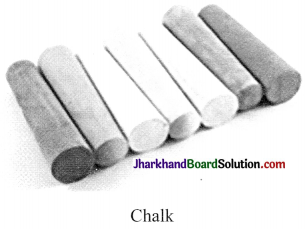



![]()
![]()

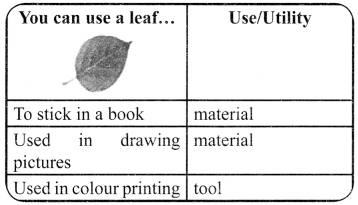
![]()
![]()
![]()
